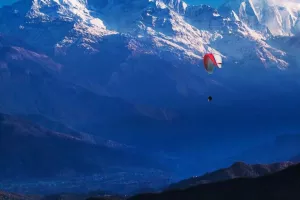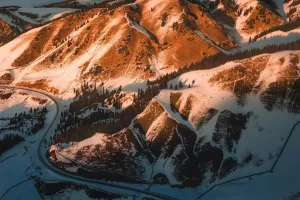With vast freshwater reserves and over 1,500 lakes, Switzerland is known as “Europe’s Reservoir,” and the country’s epic landscapes are largely defined by water. No wonder this landlocked country has for generations protected this most precious resource that generates such a huge diversity of natural features, from majestic rivers such as the Rhine and the Rhone and enormous lakes like Lucerne and Geneva, to the towering alpine glaciers and high waterfalls that tumble from cliffs above mountain villages.
The Swiss expertly manage their country’s water sources so that not only do they remain clean and abundant, but the lakes and rivers they feed are also a thriving playground for the nation. Most Swiss drinking water comes from underground water reserves and natural springs; water is not merely a natural commodity, it is a life force, both culturally and historically. And thanks to the nation’s flair for ingenuity, the Swiss are able to enjoy water in a variety of intriguing ways: as an adventure, as a journey, as a place to swim. Jump in, Swiss style, the water’s lovely!
Water, water everywhere
Whether you want a quick dip in warm water, a marathon swim down a river, or a plunge into freezing glacial waters, it’s not hard to find a place to swim anywhere in Switzerland thanks to the country’s enormous network of lakes and rivers. The Swiss have carved out an impressive network of swimming locations, often in awe-inspiring places. Public beaches and outdoor pools, or lidos, are many things: community hubs, children’s playgrounds, fitness centers, and in Switzerland, they’re also a place of scenic beauty. Many are lakeside, such as along the shores of Lake Maggiore, where you can bask on a huge sandy beach in full view of the mountains, and at Piscine de Bellerive by Lac Léman, where Lausanne locals have been swimming for over 75 years and there’s a choice of three large swimming pools.
The Frauenbad at Stadthausquai are female-only swimming baths, while the Three Ponds above St. Gallen feature art nouveau bathhouses.
But swimming isn’t confined to the rural outdoors. Most Swiss cities are built around a great river which runs through the city’s heart. And urban residents don’t just mess about in rivers for fun, some actually commute to work―in the river! In Basel, Berne, Geneva, and Zurich, locals don caps and goggles to kickstart their work day with a fast-flowing fluvial commute. It’s an invigorating way to earn your first cup of coffee at the office. In Basel, swimmers head to the Kleinbasel banks of the Rhine between the Wettsteinbrücke and Johanniterbrücke bridges where the current provides a helping hand downriver.
Of course, the locals have thought of everything, there are convenient concrete steps down to the river, and you can put your work clothes and phone in a large waterproof swim bag―an original Basel invention―that you tow as you swim through the picturesque medieval Old Town. And don’t worry about the quality and safety of the water, for years the Swiss have diverted domestic wastewater away from rivers, and guidelines and handy maps marking the safe swimming areas are on hand.
Water odysseys
With such a bounty of mountain lakes, rivers, and waterways, the Swiss have come up with a multitude of ways to travel over them, from adrenaline-fueled whitewater rapids trips along fast-flowing alpine rivers to family-friendly guided float trips over calm warm waters. Interlaken, located beneath the watershed of the Eiger, Monch, and Jungfrau mountains, is a hotspot for rafting: here you can raft down some of the most scenic―and challenging―water courses in Switzerland and experience the power of big rivers.
For a more sedate journey, board one of the magnificently restored paddle steamers that travel up and down Lake Lucerne and Lake Geneva. These are some of the fastest and most impressive paddlewheel cruisers in Europe, and some have been in service since the early 1900s. The boats that operate from Lucerne run on a hop-on, hop-off schedule across the lake all the way to Fluelen, and offer passengers an unparalleled look back at the days when paddle steamers were the main mode of transport.
In true Swiss coordinated style, the journey doesn’t have to end there: to fully appreciate the beauty of Switzerland’s fourth largest lake whose shores are flanked by spectacular, steep mountains, disembark at Vitznau and use the Swiss Travel Pass (for combined boat and train tickets) to take the heritage steam cog train up to Mount Rigi. From here, you can admire the lake in all its breathtaking glory before taking a cable car down to Weggis, where you can board the paddle steamer back to Lucerne.
In awe of the falls
While rivers are the historic link between the Alps and Switzerland’s cities, along the way there are some magnificent waterfalls. The glacier-fed Trümmelbach Falls deep in the caves of the Lauterbrunnen Valley in the Bernese Oberland are Europe’s largest subterranean waterfalls, while Rhine Falls, near Schaffhausen, is the largest waterfall in Europe. Many Swiss waterfalls are surrounded by astounding views of forests, green valleys, and castles steeped in literature, myth, and folklore. The Reichenbach Falls is the location of the fictional fight between Sherlock Holmes and his nemesis, Moriarty, and nearby the stunning and beautiful Staubbach Falls spill down from a cliff nearly a thousand feet above the scenic village of Lauterbrunnen.
Don’t miss the view of the falls from the right side of the train as you leave the village. At Giessbach Falls near Interlaken, you can actually walk behind the falls to fully appreciate the power and deafening noise of the cascading water. To reach these falls, take a short ferry boat across Lake Brienz followed by a ride in Europe’s oldest funicular up to the secluded Grand Hotel Giessbach, a magnificent fin de siècle hotel from where, over lunch in the gardens, you can enjoy a full view of the falls. Here you can glean a sense of why water has been admired, venerated, and protected by the Swiss for generations.


